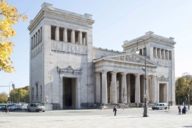
A piece of the ancient world, right in the heart of Munich: in the early 19th century, King Ludwig I commissioned the construction of Königsplatz, which was modelled after the Acropolis in Athens.
The monarch, who had a great passion for Ancient Greece, hoped that the magnificent square would become a main entrance into the city from the west while also becoming a centre of art. “I will not rest until Munich looks like Athens,” he announced when he took over the government in 1825. The ensemble of classical buildings on Königsplatz played a key role in Ludwig’s dream to turn the city into the Athens of the Isar River.
Planned by Karl von Fischer and completed by Leo von Klenze, the square in the Maxvorstadt district became a Neo-Classical work of art, housing three glorious buildings: the Propyläen (Propylaea), Glyptothek and Staatliche Antikensammlungen (State Museum of Classical Art).
The Propyläen forms the western end of Königplatz square. Leo von Klenze’s inspiration for the gate’s design was the Propylaea at the Acropolis.
The plans to build the Propyläen were delayed over the years. When the planning process first began in 1817, the gate was going to form the western gate to the city of Munich. However, by the time King Ludwig I abdicated in 1848, Munich had already stretched far beyond Königsplatz, meaning that a second city gate was no longer needed. Yet Ludwig I stuck to his original plans and paid for the Propyläen from his own pocket. It was finally inaugurated in 1862, becoming the last purely classical construction in Munich.
The newly founded state of Greece was ruled by Ludwig’s son Otto, the first King of Greece.
Its name comes from the Greek term “Propylaia”, which refers to the building at the entrance to the Acropolis in Athens. On Königsplatz, the Propyläen was intended to symbolise the bond between Bavaria and the new state of Greece, whose battle for independence received financial support from Ludwig I. The newly founded state of Greece was ruled by Ludwig’s son Otto, the first King of Greece. Statues and relief work on the towers depict the Greeks’ fight for freedom from the Ottoman empire.
With its Doric pillars, the Propyläen also forms the architectural conclusion between the Ionic pillars of the neighbouring Glyptothek Museum and the Corinthian pillars of the Staatliche Antikensammlungen. Leo von Klenze therefore managed to reflect all three Greek architectural styles in the buildings on Königsplatz.
However, Königsplatz has also lived through a darker period: in 1935, Adolf Hilter had the square covered completely in granite so that he could use it to hold parades for party events. He also had temples built to honour those who died in the Beer Hall Putsch of 1923 at the eastern end of the square. And in Arcisstrasse, right next door to these temples, was the entrance to Hitler’s Führerbau (the Führer’s Building), which was completed in 1937. The Nazi’s former prestigious, public building now houses Munich Hochschule für Musik und Theater (University of Music and Performing Arts).
Following the Second World War, during which Königsplatz sustained heavy bombing damage, the square was used mostly for parking and was not restored to its original appearance until the end of the 1980s.
Königsplatz is now once again a wonderful place to pass the time away: its green spaces and stone steps are an ideal spot for some sunbathing. In the summer months, it hosts open air concerts and cinema events.